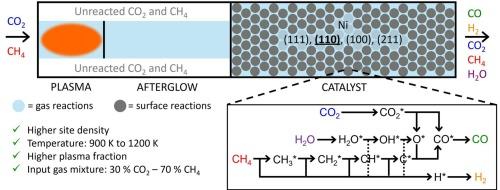等离子体后催化提高甲烷在滑行弧等离子体中干重整转化的微动力学模型
IF 6.5
1区 化学
Q2 CHEMISTRY, PHYSICAL
引用次数: 0
摘要
通过甲烷干重整(DRM)将温室气体CO2和CH4等离子体转化为有用的产物已经在滑行弧和其他热等离子体中显示出良好的效果,但转化和产物分布还有待进一步改进。在这项工作中,我们研究了添加等离子体后Ni催化剂,通过催化DRM反应实现额外的CO2和CH4转化的效果。我们建立了一个0D微动力学模型来计算等离子体、余辉和催化剂表面的气相和表面反应,可以用来研究两种转化趋势,以及潜在的反应机制。我们测试了一系列相关参数,结果表明转化率有所提高,特别是在高催化剂位置密度、催化剂床气温度和等离子体转化气体的比例下。在最佳的30/70的CO2/CH4输入气体混合物中,我们的模型预测,添加Ni催化剂后,CO2和CH4的转化率分别从25%增加到68%和43%。途径分析表明,吸附的C原子(C*)起着至关重要的作用,在与O*重组为CO*时,它们连接了CO2和CH4的转化机制,但必须保持平衡以避免C*中毒。此外,该途径依赖于Ni面,大多数转换发生在Ni上(1 1 0)。总的来说,我们的模型证明了将等离子体后催化整合到热等离子体中的积极作用,通过调整输入条件,指导实验工作获得尽可能高的转换。本文章由计算机程序翻译,如有差异,请以英文原文为准。

Microkinetic modelling of post-plasma catalysis to improve the conversion of dry reforming of methane in a gliding arc plasmatron
Plasma conversion of the greenhouse gases CO2 and CH4 into useful products via dry reforming of methane (DRM) has shown promising results in gliding arc and other warm plasmas, but the conversions and product distribution can be further improved. In this work, we investigate the effects of adding a post-plasma Ni catalyst, to achieve extra CO2 and CH4 conversion via the catalytic DRM reaction. We developed a 0D microkinetic model to calculate gas-phase and surface reactions in the plasma, afterglow, and catalyst surface, which can be used to study both conversion trends, as well as the underlying reaction mechanisms. We examined a range of relevant parameters, and the results show an improvement in conversion, especially at high catalyst site density, catalyst bed gas temperature and fraction of gas converted by the plasma. At the optimal 30/70 CO2/CH4 input gas mixture, our model predicts an increase in conversion from 25 %, to 68 % and 43 % for CO2 and CH4, respectively, upon Ni catalyst addition. The pathway analysis reveals that adsorbed C atoms (C*) play a critical role, and upon recombination with O* into CO*, they link the CO2 and CH4 conversion mechanisms, albeit a balance must be maintained to avoid C*-poisoning. In addition, the pathway depends on the Ni facet, with most conversion taking place on Ni(1 1 0). Overall, our model demonstrates the positive effects of integrating post-plasma catalysis to a warm plasma, guiding experimental work to obtain the highest possible conversions, by tuning the input conditions.
求助全文
通过发布文献求助,成功后即可免费获取论文全文。
去求助
来源期刊

Journal of Catalysis
工程技术-工程:化工
CiteScore
12.30
自引率
5.50%
发文量
447
审稿时长
31 days
期刊介绍:
The Journal of Catalysis publishes scholarly articles on both heterogeneous and homogeneous catalysis, covering a wide range of chemical transformations. These include various types of catalysis, such as those mediated by photons, plasmons, and electrons. The focus of the studies is to understand the relationship between catalytic function and the underlying chemical properties of surfaces and metal complexes.
The articles in the journal offer innovative concepts and explore the synthesis and kinetics of inorganic solids and homogeneous complexes. Furthermore, they discuss spectroscopic techniques for characterizing catalysts, investigate the interaction of probes and reacting species with catalysts, and employ theoretical methods.
The research presented in the journal should have direct relevance to the field of catalytic processes, addressing either fundamental aspects or applications of catalysis.
 求助内容:
求助内容: 应助结果提醒方式:
应助结果提醒方式:


